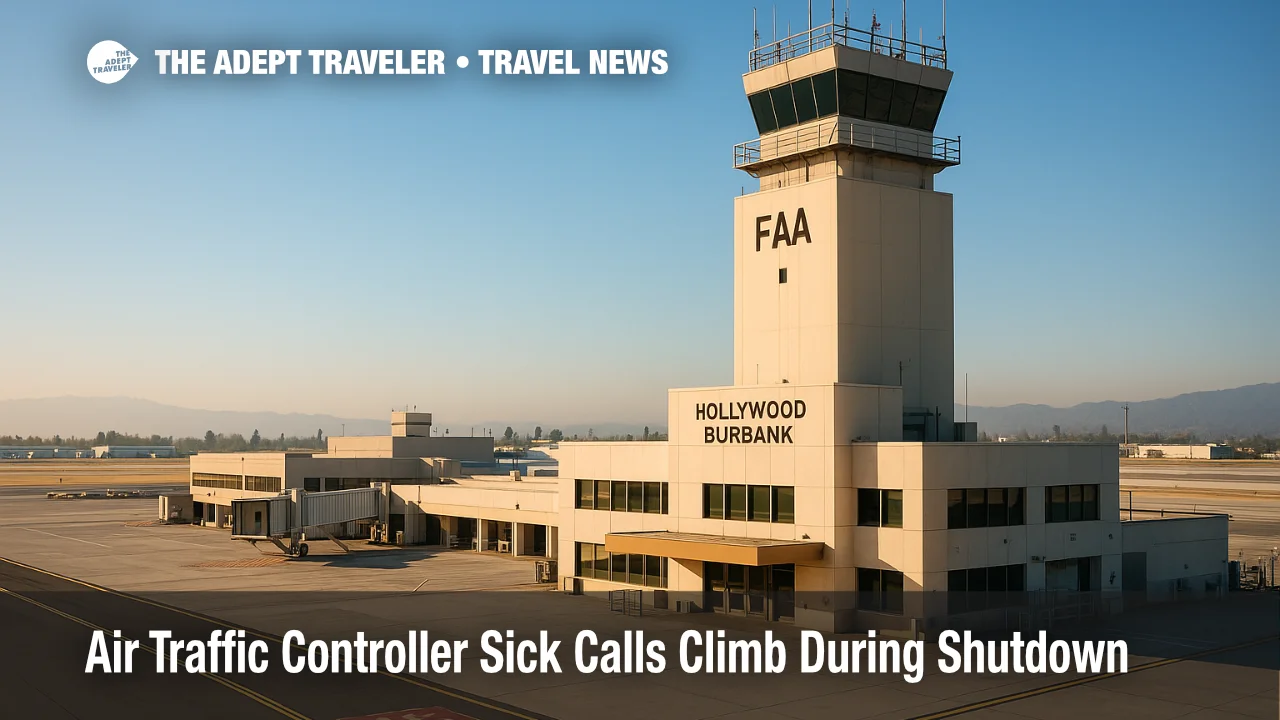Controller sick calls climb during shutdown, putting new pressure on air travel

Air traffic controller sick calls have ticked up since the government shutdown began on October 1, according to Transportation Secretary Sean Duffy, adding strain to a workforce that is currently working without pay until the government reopens. The FAA says it will slow traffic to preserve safety when staffing dips, which means more rate reductions, ground-delay programs, and uneven on-time performance at busy hubs. Monday night's ATC-zero at Hollywood Burbank Airport (BUR) shows how quickly a local gap can ripple across a metro airspace, but the core story is national: a fragile system absorbing more sick calls while controllers await paychecks.
Key Points
- Why it matters: Rising controller sick calls during the shutdown increase the odds of delay programs and localized ATC-zero events.
- Travel impact: Expect slower arrival rates, rolling delays, and isolated cancellations when facilities run thin.
- What's next: First missed paychecks on October 14 could amplify absenteeism and training slowdowns.
- Controllers are working without pay now, and will receive full back pay once funding is restored.
- Essential Air Service subsidies are at risk if the shutdown drags, pressuring small-community flights.
Snapshot
Controllers are designated essential, so they are on the job during the shutdown but not getting paid until the government reopens. Duffy said sick calls have increased slightly overall, with some facilities seeing far higher call-out rates at times. The FAA has already throttled flows into sensitive chokepoints when staffing thins, including Newark Liberty International Airport (EWR), Denver International Airport (DEN), Phoenix Sky Harbor International Airport (PHX), and Harry Reid International Airport (LAS). The most visible example so far was at Hollywood Burbank Airport (BUR), where a several-hour gap left the tower unstaffed while Southern California TRACON handled airspace separation. This is safety-conservative by design, but it trades schedule reliability for margin. If the shutdown continues into mid-October, plan for more frequent traffic-management initiatives.
Background
During the 2018-19 shutdown, controller absences at Jacksonville Center and the New York area culminated in a LaGuardia ground stop that helped end the 35-day stalemate. The baseline in 2025 is tighter: the FAA has been operating with a persistent controller shortfall, so even a modest uptick in absences can flip a facility from normal ops into reduced rates. Meanwhile, the Essential Air Service program, which supports flights to small communities nationwide, could face funding strain if appropriations lapse. For travelers, the practical takeaway is to build buffer time into connections, especially at evening banks and during weather.
Latest Developments
Sick calls rise as controllers work without pay; Burbank illustrates the stakes
The DOT reports an increase in controller sick calls since October 1. Controllers are currently working without a paycheck and will receive full back pay once the government reopens, but in the near term the missing income is a stressor that can affect attendance. On October 6, Hollywood Burbank Airport (BUR) went ATC-zero for several evening hours. Southern California TRACON kept airborne separation while surface movements slowed, pushing delays and minor cancellations. Because Los Angeles International Airport (LAX) shares the basin's airspace, rate cuts at one node can tug on the others. For a deeper explainer on how ATC-zero ripples through LAX-and how to read FAA advisories-see our guide: Burbank ATC-zero ripples to LAX: How to read FAA advisories.
Could this become a broader problem?
Yes, if the shutdown persists into the first missed controller payday on October 14. Three near-term risks stand out: 1) higher absenteeism at already thin facilities, forcing more rate reductions; 2) training and staffing pipelines slowing, extending shortages into the winter push; and 3) potential interruptions to small-community flying if Essential Air Service funds are pinched. None of these outcomes compromise safety, but they do degrade schedule reliability. Expect the FAA to "buy" safety with time by lowering arrival rates, lengthening taxi queues, and issuing more ground-delay programs at peak banks.
Analysis
Is the shutdown driving the sick-call increase? Based on DOT statements, yes-controllers are working without pay during the funding lapse, and DOT acknowledges a rise in sick calls since October 1. The Burbank incident appears consistent with that pattern: a local staffing shortfall, in a system already stretched, created a tower gap that SoCal TRACON backstopped in the air while ground flow slowed. If pay remains delayed past October 14, attendance pressure could intensify at select towers and TRACONs, particularly around evening shifts and high-demand banks. Expect the heaviest operational friction at EWR, DEN, PHX, LAS, and in Southern California, where complex airspace and tight staffing intersect. Historically, sustained attendance issues can culminate in visible choke points, as seen with New York LaGuardia Airport (LGA) during the 2019 shutdown. Travelers should monitor FAA advisories on heavy days and keep independent excursions refundable.
Final thoughts
The headline is not one airport; it is a national workforce working without pay and logging more sick calls while keeping the system safe. The FAA will keep trimming rates to protect margins, which means slower days for airlines and travelers until funding resumes. If the shutdown ends quickly, delays should ease just as fast. If it drags beyond October 14, prepare for more frequent programs, occasional ATC-zero at smaller towers, and possible strain on small-community flying. Keep plans flexible, and watch for advisories-because the path of least risk during a shutdown is the path of slower schedules.
Sources
- Transportation secretary: Shutdown adds stress, rising sick calls; Newark briefing, AP News
- Burbank tower unstaffed amid staffing crunch; controllers working without pay, The Guardian
- KABC Los Angeles: Controllers scheduled to return at Hollywood Burbank Airport
- KCAL/CBS Los Angeles: Burbank tower without controllers for hours
- 2019 LaGuardia ground stop background, NBC New York
- Essential Air Service overview, U.S. Department of Transportation
